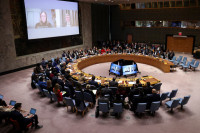Opinion
Stumbling blocks
Education and modernisation haven’t weakened ingrained socio-sexual relationships
Anjita Parajuli
Violence against women is one of the most pervasive, yet least recognised, human rights abuses in the world. According to reports, at least one in every three women around the world has been abused, either physically, sexually or emotionally. Historians agree that violence against women, which occurs in a multitude of forms, has a deep linkage with the control of female sexuality.
The regulation and management of female sexuality has a long history. Sanjog Rupakheti, assistant professor of history at Loyola University, states that control of female sexuality became institutionalised with the advent of private property, and the resultant emergence of patriarchy. He added, “In the context of Nepal, control of female sexuality was central to the creation of caste and property regimes. The elaborate marriage rules underlying the caste system was designed primarily to access different groups of women for the reproduction of particular kinds of families and lineages. Much of the obsession with blood purity, broadly speaking, is linked to property inheritance, which also led to women often being confined to the domestic realm. Historians have noted far less similar restrictions on the mobility and sexuality of women in society that do not have rigid property relations.”
Two sides of the same coin
The difference in the status of women in the so-called high caste groups and ethnic and low caste people in Nepal also supports this contention. Premarital sex and widow remarriage are quite prevalent among ethnic and the so-called low caste groups. Some indigenous groups like the Gurung and Magar have traditions like ‘rodighar’ that tend to promote a more liberal approach to sexuality. In the Tharu community, the groom’s younger brother goes to the wedding as an ‘alternate’ groom, so in case something happens to the groom, the girl can marry him. Similarly, within many Dalit communities, divorce and remarriage tend to occur with greater frequency. Women in such social groups seem to have more freedom with regard to dress code and mobility outside the home. This, however, is not to overlook the enormous burden of caste oppression that dehumanises and has historically disenfranchised them.
At the same time, the control and supervision of sexual morality among the so-called high caste groups reeks of double standards. Those who favour a literal reading of the Hindu scriptures in denying many basic rights to women do not seem to practice those very injunctions. For instance, the Hindu philosophical texts also demand abstinence from men before marriage, famously articulated in the idea of ‘brahmacharya’. But menfolk are not bound by the code in the same way. A girl who loses her virginity before marriage risks being ostracised, and faces a lifetime of social exclusion. Despite all the democratic changes in Nepal, widow marriage remains a taboo. A few brave souls who dare to challenge the prescribed boundaries of marriage face enormous resistance from family and society. The same rule does not apply to a man who can remarry immediately following the required mourning rituals lasting 13 days.
A long way to go
‘Education’ and ‘modernisation’ have not weakened these deeply embedded socio-sexual relationships. In fact, since many of these ideas about female sexuality, purity and domesticity are internalised from an early age, they almost appear natural to many as if these relations had no history. A article entitled Glamour vs Diplomacy published in a national daily is a representative case. The condescending and voyeuristic tone used by the writer to describe women diplomats representing Nepal in foreign lands is disturbingly unsettling. The article, reducing women to their physical attributes using extremely vulgar language, offers a glimpse into the patriarchal angst that is unfortunately widespread in Nepali society. It captures the anxiety of certain males, the likes of the writer and ‘senior’ diplomats cited in the article, who seem to feel threatened by women exercising their autonomy in the corridors of power, which have been historically monopolised by men.
Instead of discussing the many intellectual contributions of women diplomats, the author solely focuses on their bodies, as if wearing certain kinds of clothes makes them morally and intellectually inferior. This vilification of a woman’s body shows that we have a long way to go in addressing historic and continuing sex and gender based discrimination in our society. The editorial decision to give space to such a violating opinion, and the absence of an apology even after huge public objection against the article, raises questions about the internalised misogyny within the media itself. This is, however, not peculiarly a ‘Nepali’ problem alone. The recent US election has laid bare the extreme misogyny pervasive in the country with the leader of the free world electing a bigot for a president who ran his entire election campaign persistently insulting and sexualising women, and who was recorded boasting about how power allowed men to do anything to women, including grabbing their genitals.
Time to ponder
Laws are changing, and people’s outlook on gender relations have certainly evolved; but there is still a lot of work that needs to done. And a society cannot be truly democratic when more than half its citizens continue to face discrimination and are required to follow arcane rules in matters pertaining to the most intimate aspects of their lives, that is their sexuality.
As American psychologist Abraham Maslow’s hierarchy of needs theory suggests, only when all physiological and safety needs, as well as needs for love, belonging and esteem are fulfilled, are we able to reach the stage of self-actualisation, which is the path to realisation of one’s full potential. Any form of violation of the rights of an individual will automatically hinder reaching the stage of self-actualisation. And since violence against women stems primarily from anxiety over female purity, it is imperative for us, men and women alike, to break free from this impulse, and help create a peaceful society where women are also awarded genuine respect as autonomous individuals and are allowed to realise their full potential.
Parajuli is associated with the Nepal Youth Foundation




 5.27°C Kathmandu
5.27°C Kathmandu












